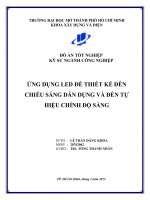HIỆU CHỈNH ĐỘ CAO ĐO ĐƯỢC BẰNG SEXTANT(Sextant Altitude Corrections )
Bạn đang xem bản rút gọn của tài liệu. Xem và tải ngay bản đầy đủ của tài liệu tại đây (3.31 MB, 33 trang )
An “Octant”
THE PURPOSE OF SEXTANT ALTITUDES
The entire purpose of taking a sextant altitude is to
get a “position line”, and that is all we get
A position line runs at right angles (i.e. @ 900) to
the bearing of a celestial body at the time of
taking a sextant altitude
The time at which we take this sextant altitude will
dictate the type of position line we obtain
THE PURPOSE OF SEXTANT ALTITUDES
A sextant altitude at Meridian Passage will give us
our latitude, but not a corresponding longitude.
A sextant altitude taken at any other time will give
a position line only
Nonetheless, when we take a sextant altitude there
are a number of corrections which we must
apply in order to obtain the True Altitude of the
body
Corrections are necessary as the observed
altitude is taken from the surface of the
earth instead of at the centre and….
In the case of the sun, the altitude of the
edge i.e. upper or lower limb of the sun is
taken rather than it’s centre
Zenith
H of E
Centre of Earth
Visible Horizon
Zenith
H of E
Visible Horizon
Centre of Earth
Visible Horizon
Zenith
H of E
Visible Horizon
Centre of
Earth
Sensible Horizon
Zenith
900
Sensible Horizon
H of E
Visible Horizon
Centre of
Earth
Rational Horizon
Zenith
Sensible Horizon
H of E
Visible Horizon
Rational Horizon
Centre of
Earth
Zenith
Sextant
Altitude
H of E
Visible Horizon
Centre of Earth
Observed Altitude:Is the angle measured between the body
and the visible horizon after the Sextant
Index Error has been applied.
Apparent Altitude:Is the angle between the limb of the body
and the sensible horizon.
Zenith
Apparent
Altitude
Sensible Horizon
Visible Horizon
H of E
Centre of Earth
True Altitude:Is the angle between the centre of the
body and the rational horizon at the
centre of the earth.
Zenith
Sensible Horizon
Visible Horizon
H of E
True
Altitude
Rational Horizon
Centre of Earth
Index Error:Error:Is an instrument error causing the sextant to
read too high or too low. It may be given as +
or - , or as “on the arc” or “off the arc”.
Dip:Dip:The observer is usually well above the surface of
the earth and is therefore looking downwards to
the visible horizon.
A negative correction is applied to bring the angle
up to the plane of the sensible horizon.
This correction is obtained from the very front
pages of the Nautical Almanac as follows
Altitude Correction Table A2
at the front of the
Nautical Almanac
• Corrections are given for HoE in
metres & feet
• There are three columns i.e. HoE
in metres; HoE in feet; the dip
correction
• The table is entered with the HoE
(feet or metres)
• Please note the range of the
tables; also interpolation will be
required in certain cases
• If the HoE matches a value in the
tables then the preceeding
correction is to be taken
Diagram
Zenith
Sensible Horizon
H of E
Visible Horizon
Rational Horizon
Centre of
Earth
DIP
Terms & Definitions
Refraction:Rays of light from the body to the observer are “bent
downwards” as they pass thru’ the earth’s
atmosphere. This makes the altitude seem greater
than it actually is and so a negative correction is
applied.
Altitudes of 100 or less should be avoided due to
abnormal refraction.









